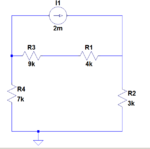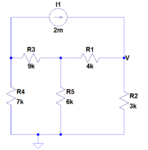olemariendal
Newbie level 5
Hi, first sorry about my english, but I will try to do my best.
Im trying to find V from this circuit, but I can´t find an solution. I know without R5, the solution is 2mA*(9kΩ+4kΩ)*(3kΩ/(3kΩ+7kΩ+9kΩ+4kΩ))=3,39V, but how do i do it, if I have a resistor between R3 and R1.
Circuit 1 without R5:

Circuit 2 with R5 on 6kΩ:

Thanks for your help. :-D
Im trying to find V from this circuit, but I can´t find an solution. I know without R5, the solution is 2mA*(9kΩ+4kΩ)*(3kΩ/(3kΩ+7kΩ+9kΩ+4kΩ))=3,39V, but how do i do it, if I have a resistor between R3 and R1.
Circuit 1 without R5:

Circuit 2 with R5 on 6kΩ:

Thanks for your help. :-D
